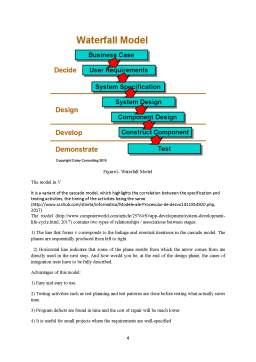Cuprins
- Contents
- LO1.1 CYCLE MODELS ...3
- LO1.2 Lifecycle stages ...9
- LO2.1 FEASIBILITY REPORT ...11
- LO 2.2 Feasibility analysis ..13
- LO 3.1 System Investigation and System Requirement Specifications (SRS) ...14
- LO3.2 ERD, DED AND DFD CONTEXT DIAGRAMS 14
- LO 3.3 System investigation .16
- LO 3.4 USER AND SYSTEM REQUIREMENTAND STRATEGIES .17
- Bibliography 19
Extras din referat
LO1.1 CYCLE MODELS
The success of a project / software product greatly depends on the working methodology used to design, develop and implement it. The correct identification of the work methodology corresponding to each type of project is based on the following two premises / considerations: Knowledge of software development methodologies, with the advantages and disadvantages related to the specificity and complexity of the product to be developed. (https://docslide.com.br/documents/abordari-ice-in-dezvoltarea-software.html, 2017)
Linear Sequence Model Waterfall (Cascade)
It is noted by a linear iterative process with a fixed number of stages in which the start of a stage takes place only after the end of the previous stage and none of the steps will be repeated later. (https://docslide.com.br/documents/abordari-ice-in-dezvoltarea-software.html, 2017) The cascade model defines the following phases in developing a program (http://www.techit.ro/analiza_software4.php, 2017):
Analyse requirements with customer
The design or architecture of the system
Implementation of the project, consisting of 2 sub-sections:
Writing code by developers, resulting in the software project
Integrate parts into the new or existing system
System verification, which includes testing and troubleshooting
Installing the client software project maintenance
Figure1- Waterfall Model
The model in V
It is a variant of the cascade model, which highlights the correlation between the specification and testing activities, the timing of the activities being the same. (http://www.scritub.com/stiinta/informatica/Modele-ale-Procesului-de-dezvo1411914920.php, 2017)
The model (http://www.computerworld.com/article/2576450/app-development/system-development-life-cycle.html, 2017) contains two types of relationships / associations between stages:
1) The line that forms v corresponds to the linkage and eventual iterations in the cascade model. The phases are sequentially produced from left to right
2) Horizontal line indicates that some of the phase results from which the arrow comes from are directly used in the next step. And how would you be, at the end of the design phase, the cases of integration tests have to be fully described.
Advantages of this model:
1) Easy and easy to use.
2) Testing activities such as test planning and test patterns are done before testing what actually saves time.
3) Program defects are found in time and the cost of repair will be much lower
4) It is useful for small projects where the requirements are well-specified
Disadvantages of this model:
1) Very rigid and not flexible
2) The software is developed during the development phase, so before this stage we have no prototypes of the software
3) If changes occur during programming, all test documents and specification documents must be updated.
This model is useful to be used in small or medium projects where requirements are clear and stable from the start. It is also preferable to use this model when we have quite advanced technical resources.
Figure2-model V
Rapid application development (RAD)
The Rapid Application Development (or RAD) model is based on prototyping and iterative model with no (or less) specific planning. In general, RAD approach to software development means putting lesser emphasis on planning tasks and more emphasis on development and coming up with a prototype. In disparity to the waterfall model, which emphasizes meticulous specification and planning, the RAD approach means building on continuously evolving requirements, as more and more learning’s are drawn as the development progresses.
Bibliografie
http://andrei.clubcisco.ro/cursuri/f/f-sym/4idp/1_Etapele_dezvoltarii_doc.pdf. (2017). Retrieved from http://andrei.clubcisco.ro.
http://www.computerworld.com/article/2576450/app-development/system-development-life-cycle.html. (2017). Retrieved from http://www.computerworld.com.
http://www.scritub.com/stiinta/informatica/Modele-ale-Procesului-de-dezvo1411914920.php. (2017). Retrieved from http://www.scritub.com.
http://www.techit.ro/analiza_software4.php. (2017). Retrieved from http://www.techit.ro.
https://docslide.com.br/documents/abordari-ice-in-dezvoltarea-software.html. (2017). Retrieved from https://docslide.com.br.
https://dokumen.tips/documents/abordari-ice-in-dezvoltarea-software.html. (2017). Retrieved from https://dokumen.tips.
https://economictimes.indiatimes.com/definition/rapid-application-development. (2017). Retrieved from https://economictimes.indiatimes.com.
https://knowledge.hubspot.com/contacts-user-guide-v2/how-to-use-lifecycle-stages. (2017). Retrieved from https://knowledge.hubspot.com.
https://www.slideshare.net/manomal1/hotel-reservation-system-66041126. (2017). Retrieved from https://www.slideshare.net.
Preview document
Conținut arhivă zip
- System analysis and design.docx































